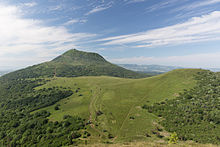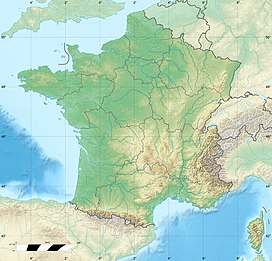geo.wikisort.org - Mountains
Puy de Dôme (US: /ˌpwiː də ˈdoʊm/,[3] French: [pɥi də dom] (![]() listen); Auvergnat: Puèi Domat [ˈpœj duˈma(t)] or Puèi de Doma [ˈpœj də ˈdumɔ]) is a lava dome and one of the youngest volcanoes in the Chaîne des Puys region of Massif Central in central France. This chain of volcanoes including numerous cinder cones, lava domes and maars is far from the edge of any tectonic plate.[4] Puy de Dôme was created by a Peléan eruption, some 10,700 years ago. Puy de Dôme is approximately 10 km (6 miles) from Clermont-Ferrand. The Puy-de-Dôme département is named after the volcano.
listen); Auvergnat: Puèi Domat [ˈpœj duˈma(t)] or Puèi de Doma [ˈpœj də ˈdumɔ]) is a lava dome and one of the youngest volcanoes in the Chaîne des Puys region of Massif Central in central France. This chain of volcanoes including numerous cinder cones, lava domes and maars is far from the edge of any tectonic plate.[4] Puy de Dôme was created by a Peléan eruption, some 10,700 years ago. Puy de Dôme is approximately 10 km (6 miles) from Clermont-Ferrand. The Puy-de-Dôme département is named after the volcano.
This article includes a list of general references, but it lacks sufficient corresponding inline citations. (April 2009) |
| Puy de Dôme | |
|---|---|
 General view | |
| Highest point | |
| Elevation | 1,465 m (4,806 ft)[1] |
| Prominence | 485 m (1,591 ft) |
| Isolation | 18.41 km (11.44 mi) |
| Coordinates | 45°46′19″N 02°57′45″E |
| Geography | |
| Location | Puy-de-Dôme, Auvergne, France |
| Parent range | Chaîne des Puys region of Massif Central |
| Geology | |
| Mountain type | Lava dome |
| Last eruption | c. 10,700 years ago[2] |
| Climbing | |
| First ascent | Unknown |
| Easiest route | road |
History

In pre-Christian Europe, Puy de Dôme served as an assembly place for spiritual ceremonies.[5] Temples were built at the summit, including a Gallo-Roman temple of Mercury, the ruins of which were discovered in 1873.
In 1648, Florin Périer, at the urging of Blaise Pascal, supported Evangelista Torricelli's theory that barometric observations were caused by the weight of air by measuring the height of a column of mercury at three elevations on Puy de Dôme.
In 1875, a physics laboratory was built at the summit. Since 1956, a TDF (Télédiffusion de France) antenna is also located there. On the top of the mountain, there is a transmitter for FM and TV.
Tourism

The Puy de Dôme is one of the most visited sites in the Auvergne region, attracting nearly 500,000 visitors a year. The summit offers expansive views of the Chaîne des Puys and Clermont-Ferrand. It is a well-known centre for paragliding.
The summit can be reached by two pedestrian paths: a southern one ("Le sentier des muletiers", formerly a Roman road) and a northern one ("Le sentier des chèvres") which runs past the Nid de la Poule crater. The GR 4 long-distance trail includes both paths to cross the mountain.
Since May 2012, visitors can also go up the mountain by train with the Panoramique des Dômes, a rack railway.
A road exists along the train tracks but it is closed to the general traffic, except for the military, service vehicles or emergencies.
At the top of the mountain, restaurants and shops are available as well as a visitor centre giving information on the history and geology of the area.
Geological heritage site
In respect of its key role in the development of volcanology as a geoscience discipline, the Puy-de-Dôme and Petite-Puy-de-Dôme volcanoes were included by the International Union of Geological Sciences (IUGS) in its assemblage of 100 'geological heritage sites' around the world in a listing published in October 2022.[6]
Sport
Cycling
In more recent times, Puy de Dôme has served as an occasional stage finish in the Tour de France. It was here that in 1964 Raymond Poulidor battled with Jacques Anquetil in one of the race's most famous moments, racing side by side up almost the entire climb; and that in 1975 Eddy Merckx was punched in the kidney by a spectator. According to Jean-François Pescheux, since the construction of a rack railway, and because of the very narrow road, the Tour would never return to the Puy de Dôme, its last ascent in the race being in 1988.[7] During the 2020 Tour de France however, the first part of the ascent was covered via the Col de Ceyssat, during the 13th stage starting in Châtel-Guyon and in 2023 the Puy de Dôme will once again be a summit finish at the Tour, being the finale to stage 9.

The road is open to cyclists only during very limited periods (when other vehicles are prohibited). In 2006 this was 7–9am on Wednesdays and Sundays between 1 May and 30 September.[8] In 2017, it was the first checkpoint in the Transcontinental Race, a nonstop, unsupported bicycle race across Europe.[9]
Motorsports
The Circuit de Charade was a motorsport street circuit built in 1957 using pre-existing roads around the base of the Puy de Dôme.[10][11] The venue hosted the French Grand Prix as well as the French motorcycle Grand Prix several times in the 1960s and early 1970s.[10][11] In 1986, the track was shortened due to safety issues and was converted into a dedicated motorsport race track hosting track days, driving schools as well as historic motorsport events.[10][11][12]
Climate
While the lower areas of the mountain are firmly oceanic (Köppen Cfb), Puy de Dôme has a humid continental (Köppen: Dfb) with borderline subalpine characteristics, thanks to its high elevation. Its classification is determined from its January average being well below the -3°C threshold (with -5°C as its usual lows), and for having over 4 months of average temperatures that exceed 10°C (the requirement for this climate category is to have at least 3 months).
| Climate data for Puy de Dôme (1981–2010 normals; extremes 1973–2017) | |||||||||||||
|---|---|---|---|---|---|---|---|---|---|---|---|---|---|
| Month | Jan | Feb | Mar | Apr | May | Jun | Jul | Aug | Sep | Oct | Nov | Dec | Year |
| Record high °C (°F) | 14.0 (57.2) |
12.8 (55.0) |
18.0 (64.4) |
20.8 (69.4) |
22.7 (72.9) |
28.4 (83.1) |
26.8 (80.2) |
28.3 (82.9) |
24.4 (75.9) |
21.3 (70.3) |
17.1 (62.8) |
17.0 (62.6) |
28.3 (82.9) |
| Average high °C (°F) | −0.5 (31.1) |
0.1 (32.2) |
3.6 (38.5) |
7.8 (46.0) |
9.8 (49.6) |
13.6 (56.5) |
16.7 (62.1) |
16.8 (62.2) |
12.8 (55.0) |
9.3 (48.7) |
5.1 (41.2) |
0.5 (32.9) |
8.2 (46.8) |
| Daily mean °C (°F) | −2.9 (26.8) |
−2.6 (27.3) |
0.9 (33.6) |
4.5 (40.1) |
6.9 (44.4) |
10.3 (50.5) |
13.2 (55.8) |
13.5 (56.3) |
10.1 (50.2) |
6.3 (43.3) |
2.7 (36.9) |
−2.2 (28.0) |
4.7 (40.5) |
| Average low °C (°F) | −5.4 (22.3) |
−5.2 (22.6) |
−1.8 (28.8) |
1.2 (34.2) |
3.9 (39.0) |
7.0 (44.6) |
9.7 (49.5) |
10.2 (50.4) |
7.5 (45.5) |
3.3 (37.9) |
0.3 (32.5) |
−4.8 (23.4) |
2.3 (36.1) |
| Record low °C (°F) | −16.5 (2.3) |
−19.0 (−2.2) |
−14.2 (6.4) |
−10.0 (14.0) |
−9.0 (15.8) |
−3.0 (26.6) |
1.0 (33.8) |
2.0 (35.6) |
−2.0 (28.4) |
−7.0 (19.4) |
−12.0 (10.4) |
−16.8 (1.8) |
−19.0 (−2.2) |
| Average precipitation mm (inches) | 51.5 (2.03) |
41.3 (1.63) |
29.4 (1.16) |
30.9 (1.22) |
65.0 (2.56) |
75.6 (2.98) |
67.9 (2.67) |
53.8 (2.12) |
62.9 (2.48) |
40.9 (1.61) |
43.2 (1.70) |
53.5 (2.11) |
610.0 (24.02) |
| Average precipitation days | 11.5 | 8.5 | 9.2 | 6.0 | 10.3 | 9.6 | 10.3 | 9.4 | 9.0 | 10.3 | 10.3 | 16.0 | 120.4 |
| Source 1: Météo Climat [13] | |||||||||||||
| Source 2: Météo Climat [14] | |||||||||||||
References
- Nicola Williams (2010). France. Lonely Planet. p. 592.
The ice-flecked summit of Puy de Dôme (1465m)
- D. Miallier; Pierre Boivin; C. Deniel; A. Gourgaud; P. Lanos; M. Sforna; Thierry Pilleyre (2010). "The ultimate summit eruption of Puy de Dôme volcano (Chaine des Puys, French Massif Central) about 10,700 years ago". Comptes Rendus Geoscience. 342 (11): 847–854. Bibcode:2010CRGeo.342..847M. doi:10.1016/j.crte.2010.09.004.
- "Dôme, Puy de". Merriam-Webster Dictionary. Retrieved 24 August 2019.
- Johannes Baier (2021). "Das Vulkanfeld Chaîne des Puys". Aufschluss. 72 (6): 310–321.
- Hubert, Henri (2013-11-12). The Greatness and Decline of the Celts. Routledge. ISBN 9781136202926.
- "The First 100 IUGS Geological Heritage Sites" (PDF). IUGS International Commission on Geoheritage. IUGS. Retrieved 3 November 2022.
- "Le Puy-de-Dôme dans le Tour de France" (in French). ledicodutour. Retrieved 19 July 2012.
- "Puy de Dôme: Clermont Ferrand". www.climbbybike.com. Retrieved 19 July 2012.
- Beltchenko, Neil. "Transcontinental Race releases 2016 controls". Bikepackers Magazine. Retrieved 26 December 2015.
- "Charade". racingcircuits.info. Retrieved 4 April 2017.
- "The Volcanic Rush of Clermont Ferrand". speedhunters.com. August 2013. Retrieved 4 April 2017.
- "A Brief History of Charade". theracingline.net. Retrieved 4 April 2017.
- "French climate normals 1981-2010". Météo Climat. Retrieved 19 September 2018.
- "Weather extremes for Puy de Dôme". Météo Climat. Retrieved 19 September 2018.
- Scarth, Alwyn; Tanguy, Jean-Claude (2001). Volcanoes of Europe. Oxford University Press. ISBN 0-19-521754-3.
- Global Volcanism Program: Chaîne des Puys
External links
На других языках
[de] Puy de Dôme
Der Puy de Dôme ist ein 1465 m hoher Vulkan im gleichnamigen Département Puy-de-Dôme und gehört zum Massif central in der Auvergne im Zentrum Frankreichs. Er ist der höchste Berg der Chaîne des Puys, der Kette der Puys[1]. Südwestlich der Chaîne des Puys liegt die Gruppe der ebenfalls ruhenden Vulkane der Monts Dore.- [en] Puy de Dôme
[es] Puy de Dôme
El Puy de Dôme es un volcán situado en el Macizo Central, en el sur de Francia. Es uno de los volcanes más jóvenes de la región Chaîne des Puys. La erupción más reciente tuvo lugar en el año 5760 a. C.[fr] Puy de Dôme
Le puy de Dôme est un dôme de lave trachytique situé dans le Massif central, à une quinzaine de kilomètres de Clermont-Ferrand ; il a donné son nom au département du Puy-de-Dôme. Âgé d'environ 11 000 ans, c'est un des volcans les plus jeunes de la chaîne des Puys.[it] Puy de Dôme (vulcano)
Il Puy de Dôme è un vulcano della Francia, alto 1.464 metri, situato nella catena montuosa del Massiccio Centrale nell'omonimo dipartimento. È il cono vulcanico più giovane della Chaîne des Puys[1]. L'eruzione più recente risale al VI millennio a.C..[ru] Дом (гора, Франция)
Дом[3][4][5], Пюи́-де-Дом[6] (фр. Puy de Dôme) — гора, молодой потухший вулкан в составе Шен-де-Пюи Центрального массива во Франции.Другой контент может иметь иную лицензию. Перед использованием материалов сайта WikiSort.org внимательно изучите правила лицензирования конкретных элементов наполнения сайта.
WikiSort.org - проект по пересортировке и дополнению контента Википедии
